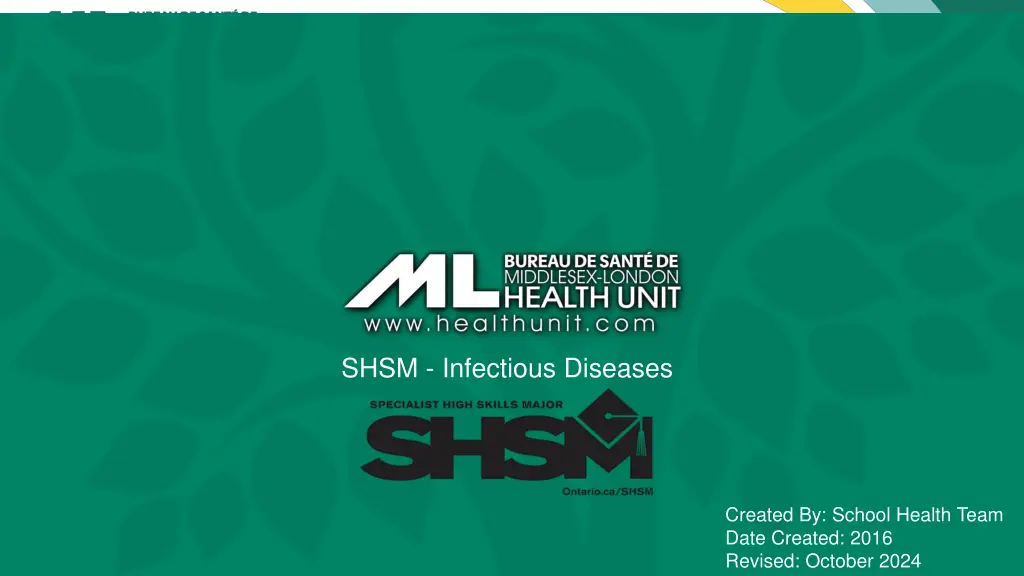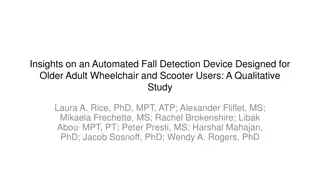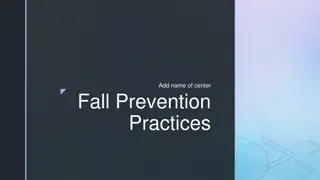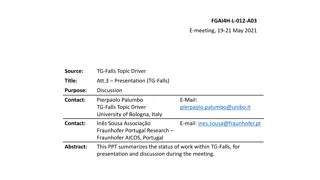
Understanding Infectious Diseases and Outbreaks in Public Health
Explore key concepts in infectious diseases including the chain of infection, outbreak definitions, and the role of health units in safeguarding public health. Learn about epidemics, pandemics, and infection control practices to prevent disease spread.
Uploaded on | 2 Views
Download Presentation

Please find below an Image/Link to download the presentation.
The content on the website is provided AS IS for your information and personal use only. It may not be sold, licensed, or shared on other websites without obtaining consent from the author. If you encounter any issues during the download, it is possible that the publisher has removed the file from their server.
You are allowed to download the files provided on this website for personal or commercial use, subject to the condition that they are used lawfully. All files are the property of their respective owners.
The content on the website is provided AS IS for your information and personal use only. It may not be sold, licensed, or shared on other websites without obtaining consent from the author.
E N D
Presentation Transcript
SHSM - Infectious Diseases Image result for SHSM logo Created By: School Health Team Date Created: 2016 Revised: October 2024
Key Learnings for Today Brief Public Health Overview Overview of Infection Control o The Chain of Infection o Breaking the Chain of Infection Activity Questions Quiz
Role of the Health Unit 34 health units in Ontario that are mandated to protect and promote the health of the public. Environmental Health School Health Immunization Infectious Disease Healthy Babies/Prenatal care Emergency Management Sexual Health
Health Protection and Promotion Act Reportable/infectious diseases or conditions must be reported to the Health Unit by: Physicians Laboratories School principals Hospitals Directors of institutions
What is an Outbreak? An outbreak is the occurrence of disease cases, in larger numbers, than what is normally expected in a localized area. Water, sanitation, food and air quality are vital elements in the transmission of communicable diseases and in the spread of diseases prone to cause epidemics. Example: Legionella Outbreak in London Ontario (Summer 2024)
What is an Epidemic? An epidemic is the unexpected spread of disease in a specific geographic area Examples: Yellow fever, smallpox, measles, and polio An epidemic disease doesn't necessarily have to be contagious. West Nile fever and the rapid increase in obesity rates are also considered epidemics.
What is a Pandemic? A pandemic is the worldwide spread of a new disease. A disease occurring over a wide geographic area and affecting an exceptionally high proportion of the population. Example: COVID-19
Infection Control A set of proven practices that help stop the spread of illness and infection.
The Chain of Infection Infectious Infectious Agent Agent Susceptible Susceptible Host Host Reservoir Reservoir Portal of Portal of Entry Entry Portal of Portal of Exit Exit Mode of Mode of Transmission Transmission
Infectious Agent An infectious agent is something that infiltrates another living thing, like you. When an infectious agent hitches a ride, you have officially become an infected host.
What is an Infection? The invasion and multiplication of microorganisms not normally present in the body such as: Bacteria Viruses Fungi Parasites
Bacteria Can thrive in many different types of environments including; extreme heat, cold, or radioactive Bacteria are larger than viruses They reproduce on their own Not all bacteria is harmful!
Bacteria Examples of infections caused by bacteria could include: Strep throat Tuberculosis (TB) Urinary tract infections Can you name some others? Can these be treated? How?
Viruses Viruses are smaller than bacteria. They require living hosts - such as people, plants or animals to multiply. When a virus enters your body, it invades some of your cells and takes over the cell machinery, redirecting it to produce the virus.
Viruses Diseases caused by viruses may include: Chickenpox Measles Common colds Can you name some others? Can these be treated? How?
Reservoirs Hiding Places Any place where an infectious agent can live People Animals Equipment Water
Fomites A fomite is any inanimate object that, when contaminated with or exposed to infectious agents, can transfer disease to a new host. Some pathogens can survive on surfaces for weeks or even months! Best advice is to Wash your Hands !
Portal of Exit The Way Out The way the Infectious Agent leaves the Reservoir Nose Blood Skin Urine/Feces
Mode of Transmission- Getting Around The way the Infectious Agent gets from the reservoir to the new host Contact Direct Indirect Contaminated Object and Airborne Person to Person or Droplet
Mode of Transmission Droplet Airborne
Mode of Transmission Vehicle Contaminated food, water medications, instruments Vector borne Mosquitoes, flies, ticks
Transmission https://www.youtube.com/watch?v=vJKA3YkVSGo https://www.youtube.com/watch?v=wrx7OpFEk2E https://www.youtube.com/watch?v=UbQ9Kl9CqUU
Portal of Entry The Way In The way the Infectious Agent gets into the next host Eyes Nose Mouth Open Wound
Susceptible Host The Next Sick Person Any person who is at risk of getting an infection from the Infectious Agent
Breaking the Chain of Infection Handwashing Cleaning & Disinfecting PPE Immunization
Breaking the Chain through Hand Hygiene Even if your hands look clean, they can still have germs that can make you sick Washing your hands removes these germs and helps to keep you healthy Handwashing with soap and water should be done for a minimum of 20 seconds Alcohol based hand sanitizer can also be used when hands are not visibly dirty, and soap and water is not available Hand sanitizer should contain 60-90% alcohol
When Should You Wash Your Hands? Examples: Before handling, preparing or serving food After using the washroom After sneezing, coughing, or blowing your nose Before eating
Handwashing Video https://youtu.be/fpXh2XHwMmE https://youtu.be/eZw4Ga3jg3E
Glo Germ Activity Glogerm Video: https://www.youtube.com/watch?v=h-O279tiR3s
Breaking the Chain of Infection through Cleaning and Disinfection Cleaning Disinfection Physical removal of foreign material (dust, soil, blood, secretions, excretions ) Inactivation of disease-causing microorganisms How: water, detergent and mechanical action How: chemical disinfectants
Breaking the Chain using Personal Protective Equipment (PPE) and Practices Gloves Gown Mask Goggles or face shield
Negative Pressure Room Optional: Video about Negative Pressure Rooms https://www.youtube.com/watch?v=4q5KCiH58uI
Breaking the Chain through Immunization What are Vaccines? Vaccines protect you and the people around you They produce immunity to a specific disease, which means you are protected from that disease Most vaccines are given by injection (needle) Vaccines work by presenting our body with something that looks like the infection so that our immune system can learn how to produce its own natural protection.
Herd Immunity Also known as Community Immunity When most people in a community are immune to a disease (through vaccination and/or prior illness), there is less opportunity for the disease to spread from person to person. Protects vulnerable people (those too young to be immunized, people undergoing chemotherapy, elderly and other medical reasons). https://www.youtube.com/watch?v=UqKP-ETVvrc
Flu Shot Match The flu shot contains 3 or 4 different strains of inactivated influenza (depending on which one you get). You want the circulating strains to be similar to those included in the yearly flu shot. The strains included in the flu shot change every year that s why it s important to get the shot every year!






















